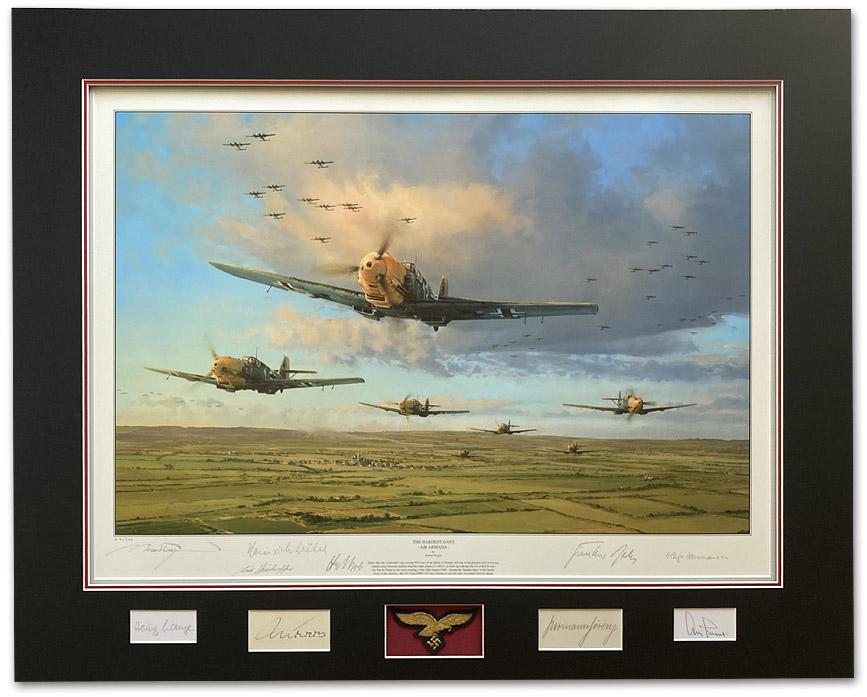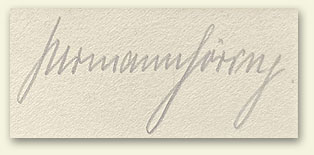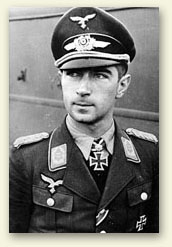
Air Armada
by Robert Taylor
- Reichsmarschall Hermann Göring & Oberst Werner Mölders -
Following Hitler's conquest of the continent, Britain stood alone, awaiting the inevitable German onslaught. To mount an invasion of the British Isles though the Germans needed to eliminate the RAF. First the Germans attacked the coastal convoys, hoping to draw the RAF en-masse into battle. They failed. And then on 12 August, they turned their full attention to the forward fighter bases and radar stations, hoping to obliterate them once and for all. |
| The Archive Presentation |
This five-signature Anniversary edition print has been triple matted to full conservation standards to includes the original wartime signatures of Luftwaffe chief Hermann Göring and the legendary Werner Mölders - one of the Luftwaffe's greatest heroes and in who's honour JG51 was named. |
| SOLD |
| Archive presentation | With the original signatures of Reichsmarschall Hermann Göring and Oberst Werner Mölders | |
| plus the signatures of an additional 7 Luftwaffe veterans of the Battle of Britain including Adolf Galland. | ||
| The signatures | |
| Hermann Göring | WWI 22 victory Ace - WWII Luftwaffe Chief and deputy Fuhrer |
| Werner Mölders | JG51 commander - 115 victory Ace |
| Adolf Galland | JG26 commander - 104 victory Ace - Commanding General of all German day and night fighters |
| Günther Rall | JG52 commander - 275 victory Ace - third highest scoring fighter Ace in history |
| Erich Rudorffer | JG54 & JG7 Commander - 224 victory Ace |
| Hans-Ekkehard Bob | JG54 Commander - 60 victory Ace |
| Heinz Lange | JG51 Commander - 70 victory Ace |
| Hajo Hermann | KG4 Commander - He111 pilot - flew inSpain, Poland, Norway and the Battle of Britain |
| Heinrich Sudel | He111 Observer flew 408 combat missions including the Battle of Britain and Eastern Front |
 Hermann Göring |
 (matted signature) |
One history's most prominent and controversial figures. A fighter Ace and national hero of the Great War, then head of the Luftwaffe and deputy Fuhrer in WWII. |
|
Göring was born on 12 January 1893 in Bavaria. At that time his father was serving as consul general in Haiti, and his mother had returned home briefly to give birth. She left the six-week-old baby with a friend in Bavaria and did not see the child again for three years, when she and Göring's father returned to Germany. At age 16, he was sent to a military academy at Berlin Lichterfelde from which he graduated with
distinction. He joined the Prince Wilhelm Regiment of the Prussian Army in 1912 and was
stationed at Mülhausen with his regiment when World War I began in August 1914. During that year Göring was hospitalized with rheumatism, a result of the damp of trench warfare.
While he was recovering, his friend Bruno Loerzer convinced him to transfer to what would
become the Luftstreitkräfte of the German army, but his request was turned down. Despite this,
later that year Göring flew as Loerzer's observer having informally transferred
himself. He was discovered and sentenced to three weeks' confinement to barracks, but the
sentence was never carried out. By the time it was supposed to be imposed, Göring's association
with Loerzer had been made official. Göring remained in aviation after the war. He tried barnstorming and briefly worked at Fokker. After spending most of 1919 living in Denmark, he moved to Sweden and joined Svensk Lufttrafik, a Swedish airline. History largely remembers Göring as head of the Luftwaffe, and debates how his decisions in that role helped direct the course of events and shape the final outcome of WWII, but obviously his prominence in the Nazi party cannot be overstated nor overlooked. The full account is too long and complex to recount here, although a fascinating and quite bizarre tale if you're inclined to separate research. However, the fact that Göring was tried and sentenced to death at Nuremberg (only to escape the sentence by committing suicide) hints at the dark elements of his story. (matted signature) |
|
|
 (matted signature) |
| Werner "Vati" Mölders was born on 18 March 1913. He had been intent on a career in the Military after his Father was killed in the First World War, and entered the Dresden Military Academy in 1932 . In 1934 he applied for flight training with the Luftwaffe passing all but one test, the centrifugal spin chair which made him dizzy and caused him to vomit, a doctor was to recommend that Molders was unfit to become a pilot. Molders was determined though and practiced with the chair until he passed. | |
| In 1938 he volunteered for the Condor Legion and eventually replaced Adolf Galland as commander of 3 Staffel of JG 88. By the 31st of October Molders had scored 14 victories in Spain and he returned to Germany as the highest scoring pilot of the Spanish conflict.
At the beginning of World War II, Mölders was Staffelkapitän of 1./JG 53 . He became known by those under his command as "Vati" (Daddy) Mölders. He shot down his first aircraft of the Second World War on 21 September 1939, on 27 May 1940, after his 20th victory he was promoted to Hauptmann and decorated with the Knight's Cross. He was shot down in combat on 5 June 1940 and was taken prisoner. He was liberated two weeks later upon the armistice with France. He returned to Germany to be promoted to Major and given command of JG 51 as Kommodore. On 28 July 1940, during his first flight with his new unit, he succeeded in downing a Spitfire, but his aircraft was then hit by the enemy aircraft. Severely wounded in the legs, just managing to make an emergency landing at Wissant, France.It was not until a month later that he was able to return to combat. He quickly brought his score up by downing 28 British fighters during the remainder of the Battle of Britain, including his 40th, a Spitfire over Dungeness, on 20 September, for which he was awarded the Oak Leaves (No. 2) the next day. By the end of the Battle of Britain he had a total of 54 victories. In June 1941 Molders was in the East, by the end of July he had 115 victories to his name. Realizing that he was too valuable to risk in combat he was grounded and at the age of just 28 became Inspecteur der Jagdflieger (Inspector of Fighters). It was around this time that Molders received notice of Ernst Udet's suicide and he requested to be one of the guard of honours at the funeral, despite very bad weather Molders took a flight in a Heinkel He-III, the plane took off in a violent thunderstorm and lost an engine during the flight. As the aircraft approached the landing strip the second engine failed, the Heinkel slammed into the ground killing Molders’ instantly. It is said that the entire nation mourned Molders passing, JG51 was awarded the name Molders in his honour. - Werner Molders was credited with 115 victories. (matted signature) |
|
 |
